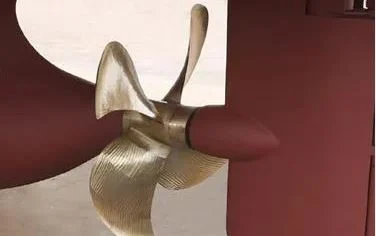When we examine ship propulsion, we usually mean the engine since it propels the ship forward. However, it’s the propeller that works quietly underwater. Without the propeller, the ship cannot move, no matter how capable the engine is.
In this article, we will clarify how ship propellers work, what materials they are made from, and the types of propellers commonly found on different ships.
How Propellers Work
It all comes down to Newton’s Third Law: for every action, there is an equal and opposite reaction.
As the blades spin, they thrust water backward. The drive that comes in return pushes the vessel forward. It’s straightforward physics, but the shape, pitch, and speed of those blades matter a lot. Most ships get that spinning power from a main engine associated by a long shaft to the propeller hub.
A ship performs better when the propeller can move water efficiently. Therefore, propeller blade design is not only about cutting the water, but also about conserving fuel, reducing vibration and lowering underwater noise.
What are Propellers made of?
Propellers confront numerous challenges, including saltwater corrosion, mechanical stress, and constant wear. In general, the materials are solid and corrosion-resistant materials, such as:
– Nickel-Aluminium Bronze
– Manganese Bronze
– Stainless Steel (on specific vessels)
The process of manufacturing is very exact. Propellers are typically cast in a solid state and then machined and fitted. Even slight imperfections can cause vibration, wear, or noise.
A propeller consists of four main components:
Hub: the central part where the shaft connects
Blades: the surfaces which would displace the water
Blade Face & Back: the pressure side and suction side
Pitch: how far it would travel in one complete rotation assuming it was cutting through a solid.
Types of Propellers
Ships are equipped with either one of two types of propellers depending on the size of the vessel or function and operational needs.
1. Fixed Pitch Propeller (FPP):
This is when the angle of the blades is held at a fixed angle. Simple and robust.
Advantage: Tough; less maintenance.
Disadvantage: Not well suited for changing conditions.
Installed on: Tankers, cargo ships, fishing boats.
2. Controllable Pitch Propeller (CPP): In a controllable pitch propeller, the angle of the blades can be varied on the go; often during rotation.
Advantages: Reduction of manoeuvrability and improvement in engine performance.
Disadvantages: More complicated and costly to maintain.
Installed on: Ferries, naval ships, complicated offshore vessels.
3. Ducted or Kort Nozzle Propeller
The design encloses the propeller in a nozzle, providing additional thrust at low speed.
Advantages: Amazing for medium, heavy towing operations
Disadvantages: May be less effective at higher speeds
Usually found in: Supply vessels, tugs
4. Twin or Multi-Propeller Configuration
Certain vessels use two or more propellers for improved control and as a backup.
Advantages: Much improved handling and standby in case of breakdown
Disadvantages: Increased cost and complexity
Found on: Cruise ships, giant oil tankers, naval vessels
5. Azimuth Thrusters (Podded Propellers)
They are capable of a 360-degree rotation and function similar to steerable engines underwater.
Advantages: Amazing manoeuvrability without a rudder
Disadvantages: Expensive and high maintenance requirement
Found on: DP vessels, cruise ships, offshore platforms
Last Thoughts
Regardless of whether it’s a simple fixed-pitch unit or an advanced azimuth pod, the fundamental task is the same — to move the vessel and keep it under control. Your choice of propeller affects more than just speed; it impacts fuel usage, noise, and how well the ship handles in tight spots.
Out at sea, it’s not continuously the flashiest systems doing the overwhelming lifting. The propeller is one of those parts that unobtrusively keeps the whole operation going


